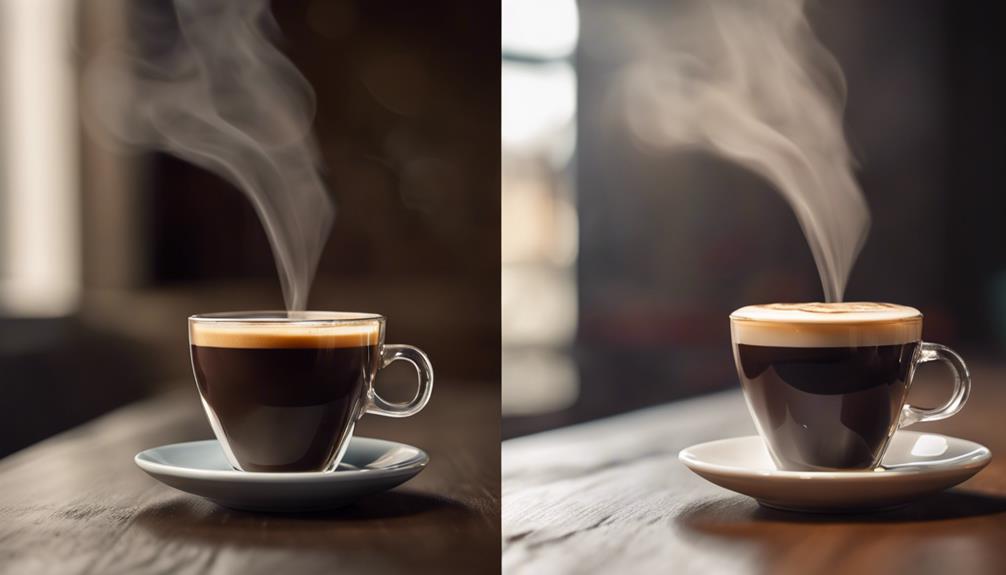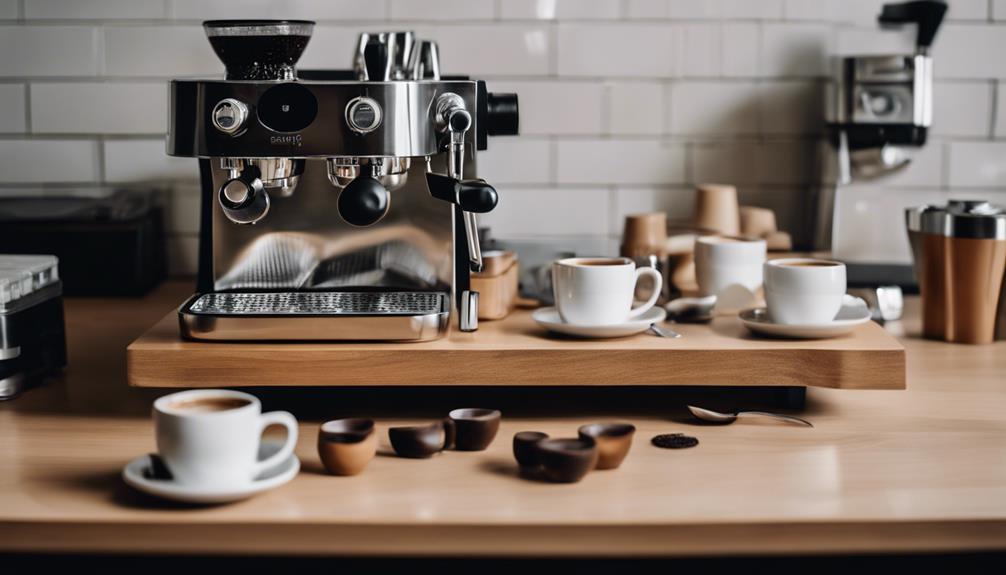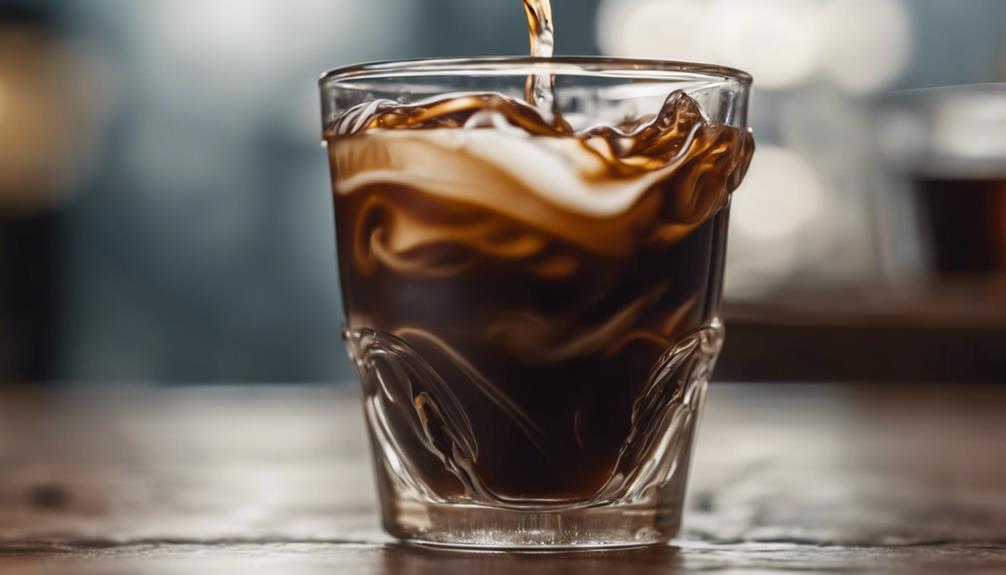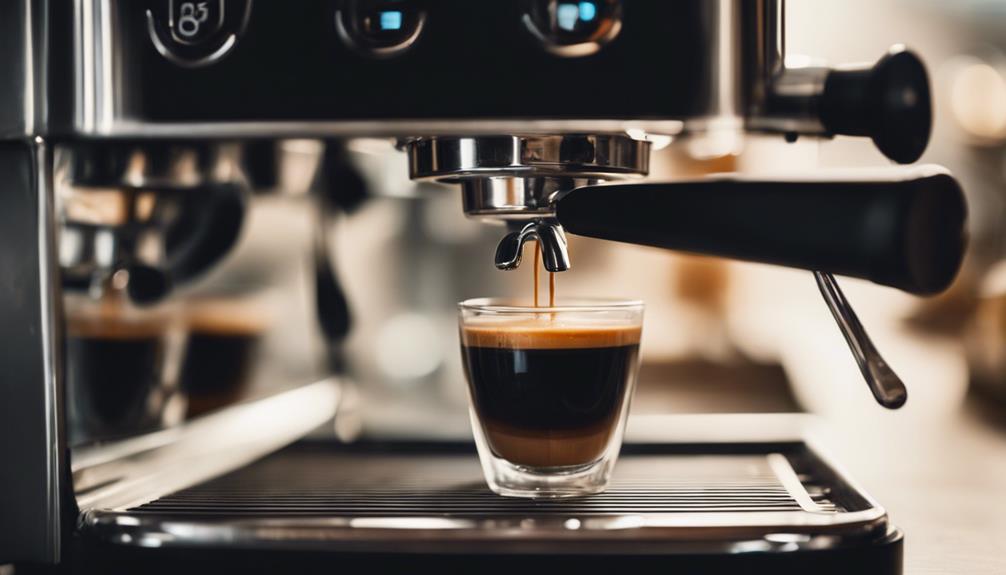You are about to learn about the unique characteristics that distinguish espresso from coffee. The brewing process is a key factor that sets them apart, with espresso being made by pushing hot water through finely ground coffee at high pressure, resulting in a quick brewing time and a rich flavor profile. On the other hand, coffee is brewed at a lower pressure with a coarser grind, taking longer to brew. Espresso also contains a higher caffeine content, with about 63mg per ounce compared to coffee’s 12mg. As you delve into these distinctions, you will discover more subtle nuances that will enhance your coffee experience and turn your daily cup into a delightful ritual.
Key Takeaways
- Espresso is made by forcing hot water through finely ground coffee at 9 bars of pressure, resulting in a quick brew time of 20-30 seconds.
- Espresso has a stronger and more intense flavor profile compared to regular brewed coffee due to its unique brewing method and dark roast beans.
- Espresso contains approximately 63 mg of caffeine per ounce, whereas brewed coffee has around 12 mg per ounce, with an 8 oz cup ranging from 95-128 mg.
- The brewing method, grind size, and coffee-to-water ratio greatly differ between espresso and coffee, with espresso requiring high pressure and a fine grind.
Understanding Espresso Basics
To truly appreciate the difference between espresso and coffee, you need to understand the unique characteristics that set espresso apart, starting with the basics of how it's made.
When brewing espresso, you're forcing hot water through finely ground coffee beans at incredibly high pressure – around 9 bars. This process yields a small, rich shot topped with a layer of crema, which you won't find in regular brewed coffee. Unlike regular coffee, espresso extraction takes a mere 20-30 seconds, resulting in a stronger and more intense flavor profile.
Espresso beans are typically darkly roasted to bring out a bold taste, although you can opt for a lighter roast, known as 'blonde espresso,' for a milder flavor. The key thing to remember is that any coffee bean can be used to make espresso – it's the grind size and brewing method that set it apart from other coffee types.
Coffee Vs Espresso: the Difference
You're probably wondering what sets espresso apart from your daily cup of coffee, and the differences are more than just a matter of taste. When it comes to espresso, the brewing process involves forcing hot water through tightly packed grounds, resulting in a concentrated and strong flavor. On the other hand, coffee is typically brewed by allowing hot water to drip through coarser grounds, producing a milder taste. When choosing between coffee and espresso, it’s important to consider your preference for the strength and intensity of the flavor, as well as the caffeine content. So, whether you prefer the boldness of espresso or the smoothness of coffee, there is something for everyone to enjoy.
When it comes to brewing, espresso and coffee have distinct methods that affect the final product.
Here are some key differences:
- Brewing method: Espresso is brewed under high pressure using finely ground coffee, while coffee is brewed with less pressure and a coarser grind size.
- Caffeine content: Espresso contains about 63 mg of caffeine per ounce, whereas coffee has approximately 12 mg per ounce.
- Brewing time: Espresso takes a mere 20-30 seconds to brew, whereas coffee brewing methods range from 6-12 minutes.
- Coffee-to-water ratio: Espresso has a ratio of about 1:2, resulting in a thicker consistency, whereas coffee generally uses a ratio of approximately 1:18, resulting in a more diluted beverage.
These differences in brewing method, caffeine content, brewing time, and coffee-to-water ratio all contribute to the distinct flavor profiles of espresso and coffee.
Espresso Bean Characteristics
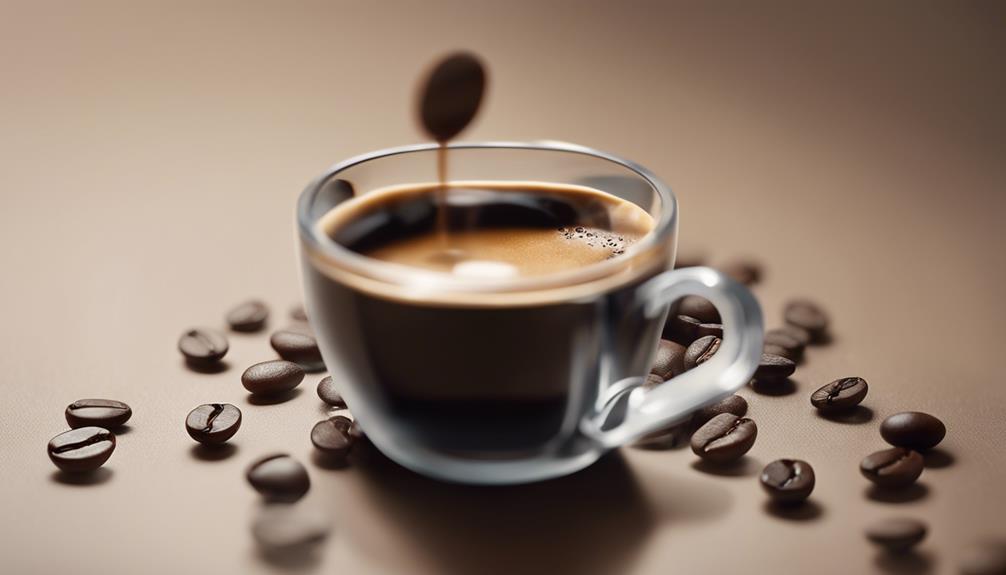
When it comes to espresso beans, you'll notice some key differences that set them apart from regular coffee beans.
You'll want to take into account the roast level, as it plays an essential role in bringing out the desired flavor profile.
As you explore the characteristics of espresso beans, you'll discover how the origin of the beans and their subsequent roast level impact the final flavor you experience.
Roast Level Importance
Frequently, espresso aficionados opt for beans with a darker roast level, as it brings out the perfect balance of flavors in their daily shots. When it comes to espresso beans, the roast level plays an essential role in the final flavor profile.
Here are some key points to take into account:
- Darker roasts enhance sweetness: A darker roast level brings out the sweetness in espresso beans, creating a balanced flavor.
- Dark roasting releases oils: The second crack during dark roasting releases oils, contributing to the creamy texture and rich mouthfeel of espresso.
- Lighter roasts can be too intense: Lighter roasted beans can produce overly intense and bright flavors when brewed as espresso, making them less suitable for this method.
- Roast level is a matter of preference: While espresso is commonly associated with dark roast beans, the choice of roast ultimately depends on your personal preference and desired flavor intensity.
Bean Origin Matters
The origin of espresso beans plays a vital role in shaping their unique characteristics, as beans from different regions and farms can exhibit distinct flavor profiles and textures that set them apart from regular coffee beans.
As you explore the world of espresso, you'll find that all espresso beans start as coffee beans, but they're typically roasted longer to bring out a distinct flavor profile and texture that's creamier than regular coffee beans.
The roasting process for espresso beans often reaches the second crack, releasing oils that contribute to the thick crema characteristic of espresso.
What's more, espresso beans can be made from any coffee bean variety, but they're usually a blend of Arabica and Robusta for a balanced flavor and enhanced caffeine content.
When it comes to brewing, the grind size of espresso beans is much finer, around 0.3 mm, which is essential for the high-pressure brewing method of espresso.
This unique combination of roasting process, grind size, and brewing method results in flavor profiles that differ considerably from drip coffee, offering bolder, more concentrated flavors that you'll love.
Flavor Profile Impact
You'll discover that the roasting process for espresso beans has a profound impact on their flavor profile, resulting in a richer, bolder taste with less acidity and a more pronounced sweetness. This is because espresso beans are typically roasted longer than regular coffee beans. The roasting process releases oils that contribute to a creamy texture and thicker mouthfeel in the final brew.
Here are some key factors that influence the flavor profile of espresso:
- Roast level: Darker roasts bring out chocolatey and caramel notes, making the flavor less bitter.
- Brewing method: The high-pressure brewing process extracts more soluble compounds from the finely ground beans, resulting in a more intense and complex flavor.
- Bean origin: The flavor profile can notably differ based on the bean origin, with variations in floral, fruity, and nutty notes.
- Caffeine content: While espresso has a higher caffeine content than coffee, the flavor profile is more nuanced and balanced.
As you explore the world of espresso, you'll find that the flavor profile is a delicate balance of these factors. By understanding how they interact, you'll be able to appreciate the unique characteristics of your favorite espresso blends.
Caffeine Content Compared
When you're deciding between an espresso and a cup of coffee, you might wonder which one packs a bigger caffeine punch.
You'll want to evaluate the amount of caffeine in each shot, as well as how the brewing method affects the level of caffeine in your drink.
As you think about your total daily intake, you'll want to weigh the pros and cons of each option.
Amount in Each Shot
A standard shot of espresso packs a caffeine punch, delivering around 63 milligrams of caffeine in just one ounce. This may seem like a lot, but when you compare it to brewed coffee, you'll find that the caffeine content per ounce is actually higher in espresso.
Here's a breakdown of the caffeine content in each:
- Espresso: 63 mg of caffeine per 1 oz. shot
- Brewed coffee: 12 mg of caffeine per 1 oz. serving
- Cup of coffee: 95-128 mg of caffeine per 8 oz. cup (depending on brewing methods)
- Latte: balanced caffeine content with 1-2 shots of espresso (around 63-126 mg)
As you can see, while espresso has a higher caffeine content per ounce, the serving size is typically much smaller than a cup of coffee.
This means that the total caffeine intake from a cup of coffee can be considerably higher than a single shot of espresso. Keep this in mind when ordering your favorite drinks and be mindful of your caffeine intake.
Brewing Method Affects Level
The way you brew your coffee or espresso greatly impacts the caffeine content, and understanding these differences can help you optimize your daily cup.
The brewing method for espresso involves high pressure extraction, which concentrates the caffeine, resulting in a more intense flavor and higher caffeine content per ounce. On the other hand, coffee is brewed using gravity, resulting in a more diluted caffeine content. This difference in brewing method affects the total caffeine you get in your cup.
For instance, an 8 oz. cup of coffee can deliver a total caffeine content of 96 mg to 128 mg, making it higher in total caffeine than a single shot of espresso. Additionally, the rapid brewing time of espresso, which takes only 20-30 seconds, contrasts with coffee's longer brewing time of 6-12 minutes, which impacts the total caffeine extraction.
Total Daily Intake
You're likely wondering how these caffeine content differences impact your total daily intake, especially if you consume multiple cups throughout the day. The answer lies in understanding the serving size and brewing methods of both espresso and coffee. Here are some key points to contemplate:
- Serving size matters: An 8 oz. cup of coffee generally delivers more total caffeine than a 1 oz. shot of espresso, despite espresso's higher caffeine concentration per ounce.
- Brewing methods affect caffeine levels: Coffee's caffeine content can vary considerably based on brewing methods, with techniques like French press or drip influencing the final content.
- Espresso's caffeine content is more predictable: Unless you add extra shots, espresso's caffeine content remains constant, making it easier to manage your caffeine intake in espresso-based drinks.
- Balance your coffee and espresso habits: Be mindful of your total daily intake by balancing your coffee and espresso consumption, considering the serving size and brewing methods used.
Roast Levels and Brewing Methods
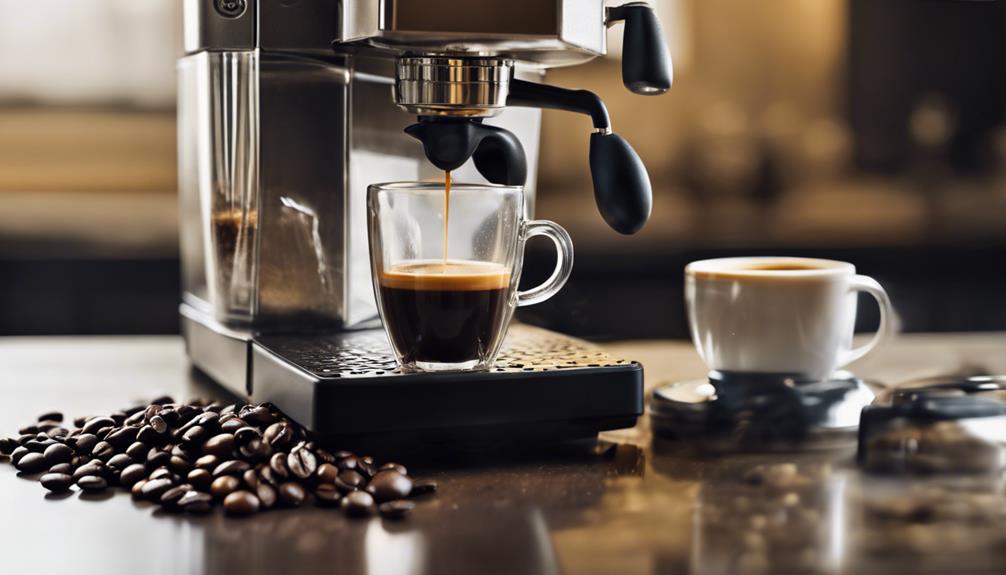
When it comes to roast levels, espresso and coffee take different paths, with espresso typically relying on dark roast beans to produce its signature rich flavor profile. You'll notice that espresso beans are roasted longer to bring out a deeper flavor, whereas coffee beans can be light, medium, or dark roasted depending on your taste preferences.
The brewing methods also differ greatly. For espresso, you'll need finely ground beans to force hot water through at high pressure (around 130 lbs of force) for about 20-30 seconds. This results in a higher extraction percentage, making the flavor more intense. On the other hand, coffee brewing methods like French press or drip rely on gravity and take longer, averaging 6-12 minutes.
The grind size is also essential, with espresso requiring an extremely fine grind (around 0.3 mm) for high-pressure brewing. Coffee, however, can be brewed with a coarser grind.
Understanding these differences in roast levels and brewing methods will help you appreciate the unique characteristics of espresso and coffee.
Espresso Machines and Techniques
Your journey into the world of espresso begins with the machine itself, a precision instrument that harnesses high pressure to extract the perfect shot. You'll need to understand the inner workings of espresso machines to brew high-quality coffee.
Here are some key aspects to take into account:
- Precision brewing: Espresso machines use high water pressure (around 15 bars) to force hot water through finely ground coffee, resulting in a concentrated shot with a rich crema.
- Technique is key: The brewing process takes about 20-30 seconds, requiring precise techniques such as dosing, grinding, and tamping for ideal extraction.
- Fast-heating technology: Modern espresso machines feature fast-heating thermocoil technology, allowing water to reach the ideal brewing temperature of 190-196°F in under 45 seconds.
- Customization options: Semi-automatic espresso machines provide a balance of manual and automatic controls, allowing you to customize shot dosage and volume while maintaining consistency.
With the right machine and techniques, you'll be able to create a range of espresso-based drinks.
Remember to invest in essential tools like a portafilter, tamper, and milk frother to enhance your overall espresso experience.
Coffee Culture and Appreciation
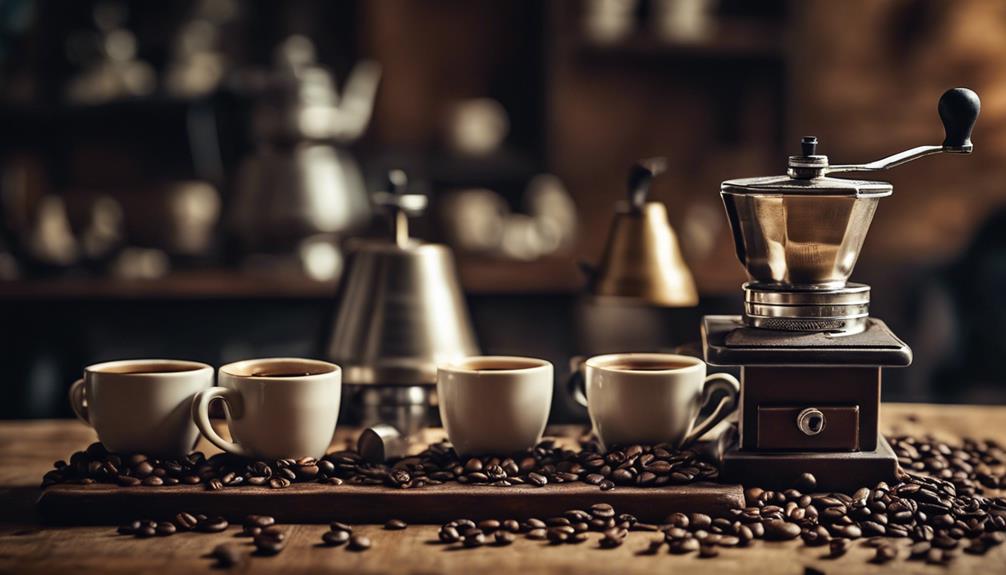
As you master the art of espresso-making, you're likely to find yourself drawn into the rich tapestry of coffee culture, where the perfect shot is just the beginning of a fascinating journey.
You'll discover that coffee culture is more than just a cup of joe; it's about understanding the nuances of different brewing methods, such as espresso versus drip coffee, and how they impact flavor profiles.
As you explore further, you'll examine various coffee bean types, like Arabica and Robusta, which contribute to distinct taste experiences and sustainability considerations.
Your appreciation of coffee will grow as you learn about the rich history of coffee culture, from its origins in Ethiopia to its spread across the globe.
You'll find yourself appreciating the art of coffee-making, from bean selection to brewing techniques, and how they come together to create a rich sensory experience.
By embracing coffee culture, you'll transform your daily routine into a delightful ritual, where every sip is a celebration of flavor, aroma, and community.
Espresso and Coffee Origins
Coffee's fascinating history begins in Ethiopia around 850 A.D., where coffee plants originated and were first consumed by Sufi monks in Yemen during the 15th century. As you investigate the rich origins of coffee and espresso, you'll discover how these beverages have evolved over time. Here are some key milestones in their history:
- Coffee's spread through the Ottoman Empire: In the early 1500s, coffee's popularity spread through the Ottoman Empire, eventually reaching Europe in the 17th century, where coffee houses began to emerge.
- The birth of espresso: In 1884, Angelo Moriondo patented the first espresso machine, which brewed larger quantities. Later, in 1903, Luigi Bezzera developed the single-serve espresso machine.
- Italy's espresso culture: Italy is recognized as the birthplace of espresso, where the brewing method quickly became integral to coffee culture.
- Innovations in brewing techniques: Throughout history, innovations in brewing techniques and machinery have shaped the distinct identities of coffee and espresso, leading to the espresso versus coffee debate.
As you explore the world of coffee and espresso, you'll find that understanding their origins is essential to appreciating their unique characteristics, uses, and brewing methods.
Brewing Methods and Extraction
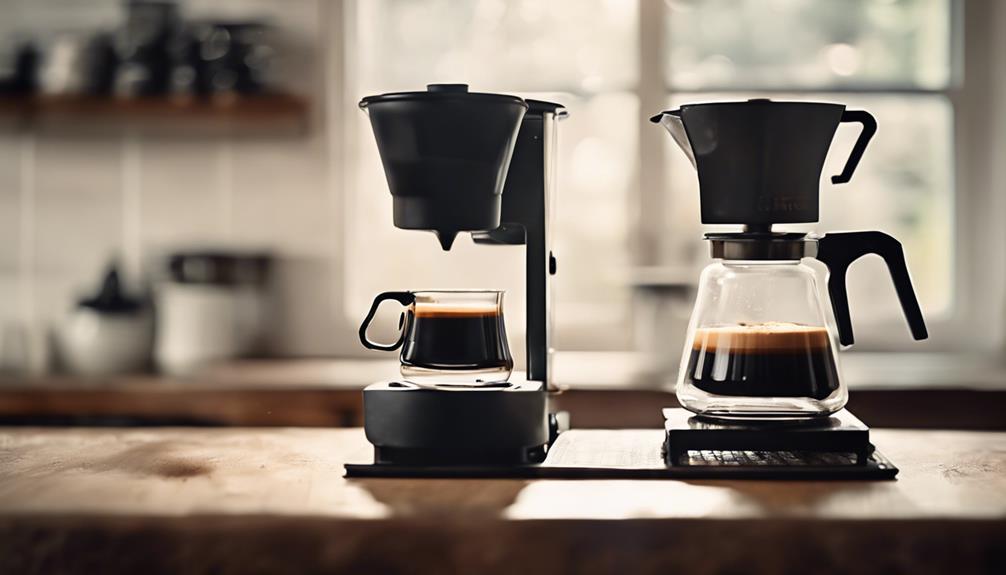
When you explore the world of coffee and espresso, you'll discover that brewing methods and extraction techniques play an essential role in shaping their distinct flavors and textures.
Espresso brewing, for instance, involves forcing hot water through finely-ground coffee at high water pressure (around 15 bars), resulting in a quick extraction time of about 20-30 seconds. This process demands precision, as the grind size and pressure applied during brewing greatly impact the final flavor.
In contrast, coffee brewing relies on gravity, allowing for a slower extraction process that can take anywhere from 6 to 12 minutes, using a coarser grind. The water-to-coffee ratio also differs, with espresso using a ratio of 1:2 and coffee using 1:18, contributing to the thicker consistency of espresso.
These variations in brewing methods and extraction processes lead to considerable differences in flavor profiles, with espresso yielding a concentrated and bold taste compared to the more diluted flavor of regular coffee.
Frequently Asked Questions
What Is the Main Difference Between Espresso and Coffee?
You're wondering what sets espresso apart from coffee? The main difference lies in the brewing process, with espresso using high pressure and finer grounds, resulting in a stronger, thicker drink with a unique crema on top.
How Can You Tell if Coffee Is Espresso?
You can tell if coffee is espresso by its strong, bold flavor, thick consistency, and rich crema on top, as well as its quick brewing time and higher caffeine content per ounce.
What's the Difference Between American Coffee and Espresso?
As you wonder what sets American coffee apart from espresso, it's no coincidence that you're about to uncover the distinct brewing methods, flavor profiles, and caffeine contents that make these two coffee styles unique, with espresso being more concentrated and rich.
Is Espresso Stronger Than Coffee?
You're wondering if espresso is stronger than coffee? Well, yes, it is! Espresso packs a punch with its intense flavor and higher caffeine concentration per ounce compared to coffee.
Conclusion
You've now revealed the secrets of espresso and coffee, and the differences that set them apart.
You've learned about the beans, the roast, the brew, and the machines that bring these drinks to life.
As you sip your next cup, remember that espresso is about intensity, richness, and a concentrated punch, while coffee is about nuance, complexity, and a subtle charm.
Both have their own unique magic, and now you can appreciate them for what they truly are.
